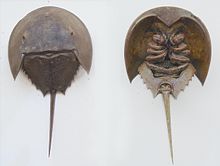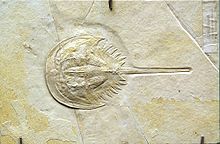- Xiphosura
-
Xiphosura
Temporal range: Silurian–Recent
Limulus polyphemus Scientific classification Kingdom: Animalia Phylum: Arthropoda Subphylum: Chelicerata Class: Merostomata Order: Xiphosura
Latreille, 1802 [1]Xiphosura is an order of marine chelicerates which includes a large number of extinct lineages and only four recent species in the family Limulidae, which include the horseshoe crabs. The group has hardly changed in millions of years; the modern horseshoe crabs look almost identical to prehistoric genera such as the Jurassic Mesolimulus, and are considered to be living fossils.
Xiphosura are traditionally placed in the class Merostomata, although this term was originally intended to encompass also the eurypterids, whence it denoted what is now known to be an unnatural (paraphyletic) group. Although the name Merostomata is still seen in textbooks, without reference to the Eurypterida, some have urged that this usage should be discouraged.[2]
Contents
Description
Modern xiphosurans reach up to 60 centimetres (24 in) in adult length, but the Paleozoic species were often far smaller, some as little as 1 to 3 centimetres (0.4 to 1.2 in) long.
The body is covered with heavy mineralized cuticle, and is divided into an anterior prosoma and a posterior opisthosoma, or abdomen. The upper surface of the prosoma is covered by a semicircular carapace, while the underside bears five pairs of walking legs and a pair of pincer-like chelicerae. The mouth is located below the forward tip of the carapace, and lies behind a lip-like structure called the labrum.[3]
Xiphosurans have up to four eyes, located in the carapace. There are a pair of compound eyes on the side of the prosoma, and one or two median ocelli towards the front. The compound eyes are simpler in structure than those of other arthropods, with the individual ommatidia not being arranged in a compact pattern. They can probably detect movement, but are unlikely to be able to form a true image. In front of the ocelli is an additional organ that probably functions as a chemoreceptor.[3]
The first four pairs of legs end in pincers, and have a series of spines, called the gnathobase, on the inner surface. The spines are used to masticate the food, tearing it up before passing it to the mouth. The fifth and final pair of legs, however, have no pincers or spines, instead having structures for cleaning the gills and pushing mud out of the way while burrowing. Behind the walking legs are a sixth set of appendages, the chilaria, which are greatly reduced in size and covered in hairs and spines.[4] These are thought to be vestiges of the limbs of an absorbed first opisthosomal segment.[3]
The opisthosoma is divided into a forward mesosoma, with flattened appendages, and a metasoma at the rear, which has no appendages. In modern forms, the whole of the opisthosoma is fused into a single unsegmented structure.[5] The underside of the opisthosoma carries the genital openings and five pairs of flap-like gills.[3]
The opisthosoma terminates in a long caudal spine, commonly referred to as a telson (though this same term is also used for a different structure in crustaceans). The spine is highly mobile, and is used to push the animal upright if it is accidentally turned over.[3]
Internal anatomy
The mouth opens into a sclerotised oesophagus which leads to a crop and gizzard. After grinding up its food in the gizzard, the animal regurgitates any inedible portions, and passes the remainder to the true stomach. The stomach secretes digestive enzymes, and is attached to an intestine and two large caeca that extend through much of the body, and absorb the nutrients from the food. The intestine terminates in a sclerotised rectum, which opens just in front of the base of the caudal spine.[3]
Xiphosurans have a well-developed circulatory system, with numerous arteries that send blood from the long tubular heart to the body tissues, and then to two longitudinal sinuses next to the gills. After being oxygenated, the blood flows into the body cavity, and back to the heart. The blood contains haemocyanin, a blue copper-based pigment performing the same function as haemoglobin in vertebrates, and also has blood cells that aid in clotting.[3]
The excretory system consists of two pairs of coxal glands connected to a bladder that opens near the base of the last pair of walking legs. The brain is relatively large, and, as in many arthropods, surrounds the oesophagus. In both sexes, the single gonad lies next to the intestine and opens on the underside of the opisthosoma.[3]
Reproduction
Xiphosurans move to shallow water to mate. The male climbs onto the back of the female, gripping her with his first pair of walking legs. The female digs out a depression in the sand, and lays from 200 to 300 eggs, which the male covers with sperm. The pair then separate, and the female buries the eggs.[3]
The eggs are about 2–3 millimetres (0.08–0.12 in) across, and hatch into a larva that superficially resembles a trilobite. Indeed it is often referred to as the 'trilobite larva'. Through a series of successive moults, the larva develops additional gills, increases the length of its caudal spine, and gradually assumes the adult form. Modern xiphosurans reach sexual maturity after about three years of growth.[3]
Classification of the Xiphosura
Order Xiphosura Latreille, 1802
- †Suborder Synziphosurida
- Suborder Xiphosurida
- †Infraorder Bellinurina
- Elleriidae Raymond, 1944 (Upper Devonian to Upper Carboniferous)
- Euproopidae Eller, 1938 (= Liomesaspidae Raymond, 1944) (Upper Carboniferous to Lower Permian)
- Bellinuridae Zittel & Eastman, 1913 (Middle Devonian to Upper Carboniferous)
- Infraorder Limulina
- †Rolfeiidae Selden & Siveter, 1987 (Early Carboniferous to Early Permian)
- †Paleolimulidae Raymond, 1944 (Carboniferous to Permian)
- †Moravuridae Pribyl, 1967 (Mississippian)
- †Austrolimulidae + †Heterolimulidae (Middle Triassic)
- Limulidae Zittel, 1885
- †Mesolimulinae Størmer, 1952 (Lower Triassic to Cretaceous)
- Limulinae Zittel, 1885
- Tachypleini Pocock, 1902 (Miocene to Recent)
- Limulini Zittel, 1885 (Recent)
- †Infraorder Bellinurina
Taxa removed from Xiphosura
There are two groups originally included in the Xiphosura, but which have been assigned to separate classes:
- Aglaspida Walcott, 1911 (Cambrian to Ordovician)
- Chasmataspida Caster & Brooks, 1956 (Lower Ordovician)
See also
- Synziphosurine
- List of xiphosurans
References
- ^ Mikko Haaramo (21 March 2003). "Xiphosura - Horseshoe crabs". Mikko's Phylogeny Archive. http://www.helsinki.fi/~mhaaramo/metazoa/protostoma/arthropoda/xiphosura/Xiphosura.htm.
- ^ H. B. Boudreaux (1979). Arthropod Phylogeny with Special Reference to Insects. John Wiley & Sons. pp. 1–320.
- ^ a b c d e f g h i j Robert D. Barnes (1982). Invertebrate Zoology. Philadelphia, PA: Holt-Saunders International. pp. 590–595. ISBN 0-03-056747-5.
- ^ R. C. Brusca & G. J. Brusca (2002). Invertebrates. Massachusetts: Sinauer Associates.
- ^ Lyall I. Anderson & Paul A. Selden (1997). "Opisthosomal fusion and phylogeny of Palaeozoic Xiphosura". Lethaia 30 (1): 19–31. doi:10.1111/j.1502-3931.1997.tb00440.x.
Further reading
- Jason A. Dunlop (1997). "Palaeozoic arachnids and their significance for arachnid phylogeny" (PDF). Proceedings of the 16th European Colloquium of Arachnology: 65–82. http://www.larruecadearacne.es/biblio/dunlop_1997.pdf.
- J. A. Dunlop & P. A. Selden (1997). "The early history and phylogeny of the chelicerates". In R. A. Fortey & R. H. Thomas (PDF). Arthropod Relationships. Systematics Association Special Volume Series 55. Chapman & Hall. pp. 221–235. ISBN 0-412-75420-7. http://homepage.mac.com/paulselden/Sites/Website/DunlopSelden1997.pdf.
- B. B. Rohdendorf (ed.) Fundamentals of Paleontology, vol. 9, Arthropoda-Tracheata and Chelicerata: 894 pp. [1991 English translation of Russian original, Smithsonian Institution Libraries and National Science Foundation].
- R. E. Snodgrass. 1952. A Textbook of Arthropod Anatomy. Hafner Publishing Company, New York.
External links
- Peripatus - an overview of arthropod relationships.
- Paleos - a site with a synoptic account of the Xiphosura, focused on fossils.
- Xiphosura - the article from the UCMP Web Taxa project.
Extant arthropod classes by subphylum Kingdom Animalia · Subkingdom Eumetazoa · (unranked) Bilateria · (unranked) Protostomia · Superphylum EcdysozoaChelicerata Arachnida (Araneae · Scorpiones · Opiliones · Acari · Pseudoscorpionida · Amblypygi · Thelyphonida · Solifugae · Palpigradi · Ricinulei · Schizomida) · Xiphosura · PycnogonidaMyriapoda Hexapoda Crustacea Branchiopoda · Remipedia · Cephalocarida · Maxillopoda (Cirripedia, Copepoda) · Ostracoda · Malacostraca (Decapoda, Amphipoda, Isopoda)Categories:- Arthropods
- Xiphosura
Wikimedia Foundation. 2010.

